If you are an owner of a country house or a house in suburban area, especially if it is a newly acquired mansion, you are probably facing with the question of building a fence. There are many solutions to this problem such as fences made of profiled sheet, brick, metal, etc. Today we will focus on how to build a horizontal fence made of wood with your own hands.
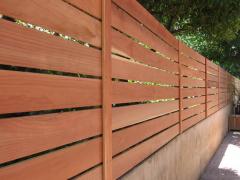 Why a wood fence? Firstly, that kind of fence becomes “the face” of the host, secondly, it carries not only the protective function, but also may be the decoration of your site. In case of creative approach to the manufacturing process it is possible to achieve some quite interesting results. A person who wants to build a horizontal fence with his own hands must not have any special skills in the field of construction or carpentry. The main thing is to know some very simple methods of attaching wood boards to supportive elements.
Why a wood fence? Firstly, that kind of fence becomes “the face” of the host, secondly, it carries not only the protective function, but also may be the decoration of your site. In case of creative approach to the manufacturing process it is possible to achieve some quite interesting results. A person who wants to build a horizontal fence with his own hands must not have any special skills in the field of construction or carpentry. The main thing is to know some very simple methods of attaching wood boards to supportive elements.
Let’s look closer at this simple and elegant solution – building a wood fence with horizontal boards with your own hands. It is easy to build, rather cheap, easy to use, requires minimal costs for regular repairing and updates, also it looks very attractive.
So, we proceed.
We recommend choosing wood boards of about 1 inch thick and 6-7 feet long. However, the you can choose the length of boards you like.
Preparing pegs
Prepare some wooden pegs of about 2 feet, each of them pointed. Then, according to the plan of your site, drive them around the perimeter at a distance of about 7 feet from each other. Connect stakes with a twine. Pull it to the stakes carefully.
Height decision
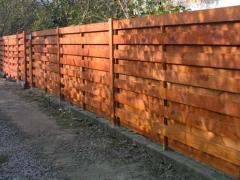 Make a decision about the height. It should neither very high nor too low, but remember that the main rule for you is not to represent your private life on public display. Typically the height of the wood fences varies from 5 to 7 feet. Cut boards of required length, treat them with a grinding-machine (you can use an ordinary electric drill with a grinding-nozzle). If you want to make a semi-circular or triangular profile, plane boards in a required way fixing them on the bench.
Make a decision about the height. It should neither very high nor too low, but remember that the main rule for you is not to represent your private life on public display. Typically the height of the wood fences varies from 5 to 7 feet. Cut boards of required length, treat them with a grinding-machine (you can use an ordinary electric drill with a grinding-nozzle). If you want to make a semi-circular or triangular profile, plane boards in a required way fixing them on the bench.
Placing holes
Now remove the pegs one by one and place the remaining holes (of about 1,5 feet deep) for supports of your fence. You can use an electric drill or a hand drill.
Digging and cementing.
Now you need to dig prefab foothold in the ground. These may be sections of about 1,5 feet*2 feet. Beam a set vertically using a plumb line, pour the ground well and tamp it firmly. The perfect way for them is to be cemented or concreted. Please, pay close attention to the strength of posts.
Stretching a rope for aligning
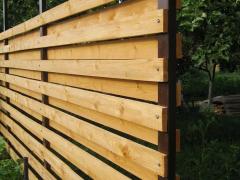 On top of each post hammer a nail and pull all the boards of your fence with a tightly stretched rope around its perimeter. This must be done in order to align a fence’s height.
On top of each post hammer a nail and pull all the boards of your fence with a tightly stretched rope around its perimeter. This must be done in order to align a fence’s height.
Connecting boards
Now connect your boards and posts using screws or nails. The size of nails or screws should conform to the thickness of boards in order them not to go through it and appear on the other side of your fence.
Finishing your fence
Apply an antiseptic agent on your fence and paint it whatever you like.
So, now your horizontal wood fence is ready! Congratulations! It will serve you well!
Related Information:
Comfort and safety. How to build a privacy fence with your hands?
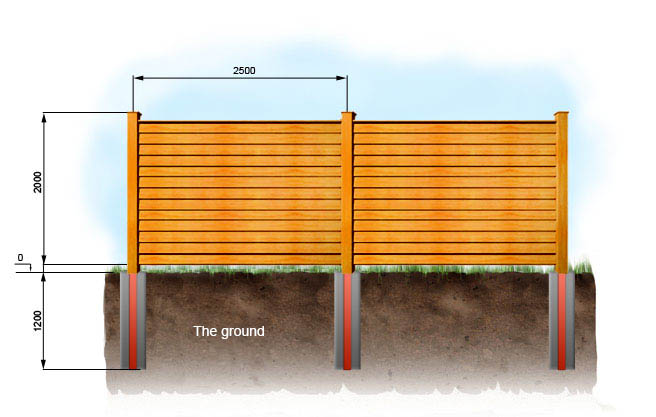
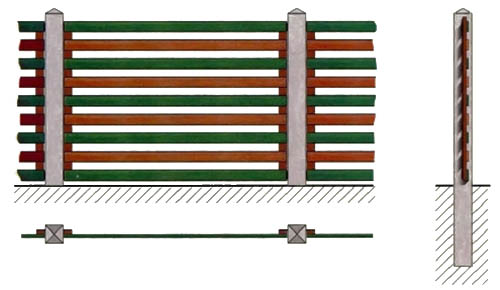


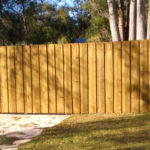

How to build a horizontal fence without a lot of effort?
This was really helpful! I have to agree the a horizontal board fence is not only functional, but also very stylish! It made my property look longer and bigger! I had mine put up by http://www.trexfencingfds.com/products/horizons/ and they did such an awesome job. Such complete and skilled professionals they are! If you want quality and cost saving in the future, give them a try!